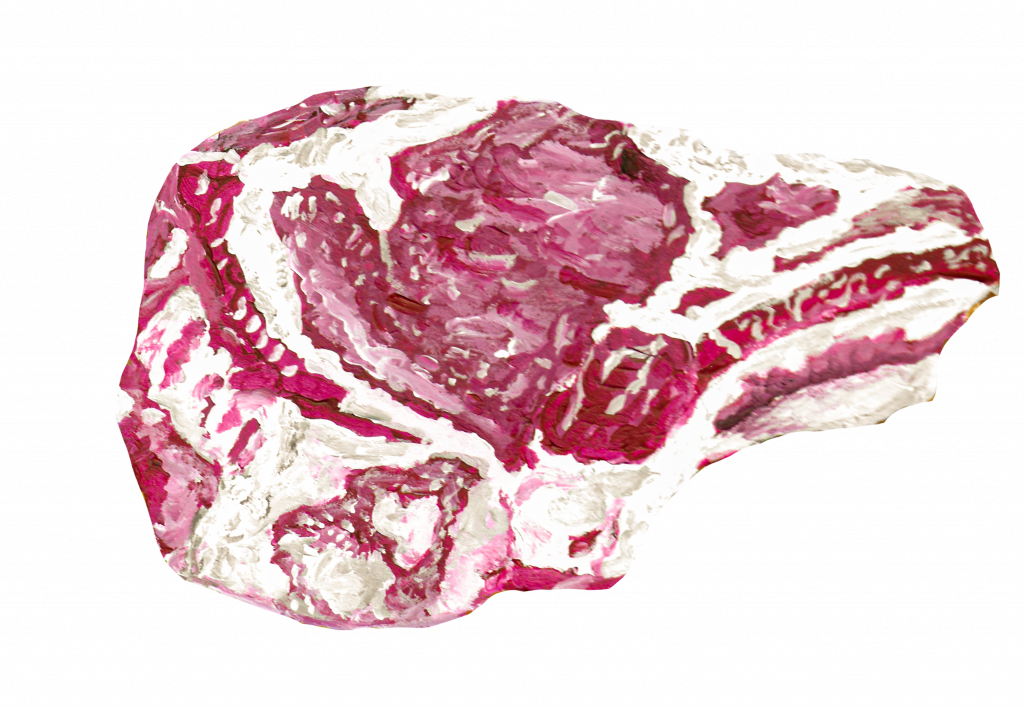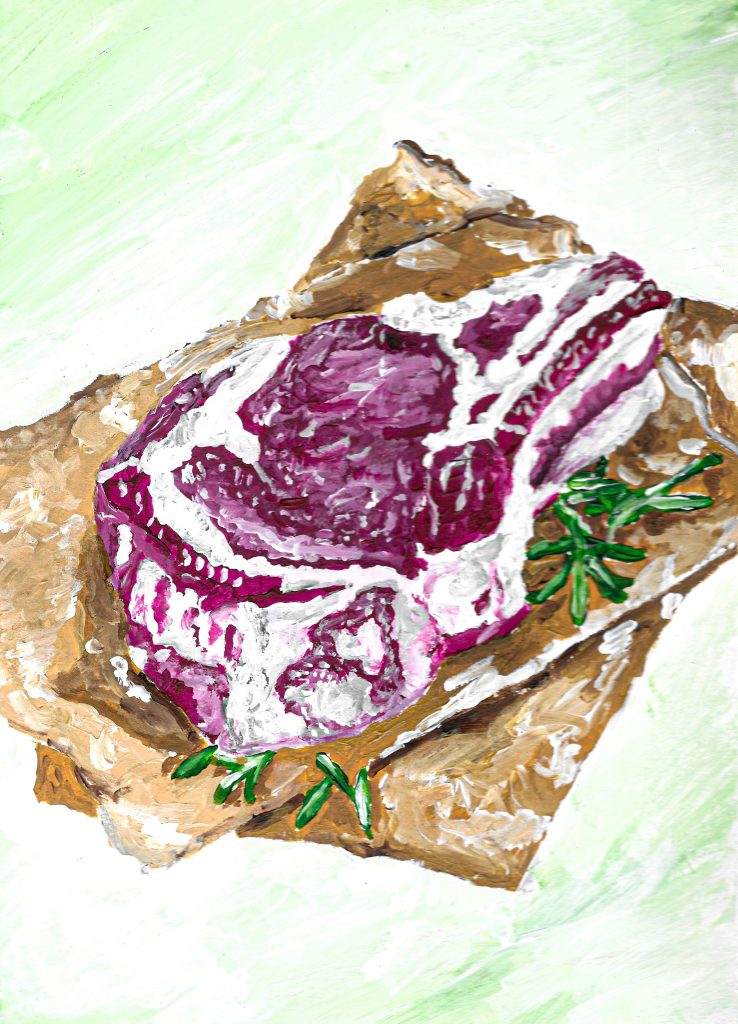
Words by James Henry | Illustration by Bill Wright
A côte de boeuf is simply not something one eats alone. I think of each côte de boeuf as a celebration.
A chance to light a fire, a chance to share a meal with friends and down a few bottles of Syrah whilst you’re at it. Basically universally adored, you can find versions of côte de boeuf from North to South America, across Africa, Australia, France, Spain and Italy, but my preferred place to partake is in the Basque Country. Here they are called Txuleta and revered with a feverish Basque pride. Txuleta are cut from old retired dairy cows, dry-aged and grilled over a carpet of glowing white embers, in cider houses dotted throughout the rolling green hills of the pays Basque.
The ethics of eating meat are certainly polarising and not exactly clear cut. For me, the industrial food system is the major issue, and if people have the chance to eat what grows seasonally and close to them, we could go a long way towards both a healthier society and a healing planet. I consider myself a responsible omnivore—basically I live on an organic farm, eat a lot of vegetables and a little bit of responsibly-caught fish, and occasionally, some well-raised meat.
Coincidentally, just as vegetables that are grown in healthy soil and without fertilisers taste best, so do responsibly-grazed animals. I favour retired dairy cows when possible, a dual purpose animal that has given milk, born calves and lived to its rightful age. These steaks will be naturally marbled with fat that has benefitted from years of grazing on spring grasses and herbs, dark red in colour with a full aroma and deep flavours. Steaks from these older cows certainly have more chew but this should be perceived as character and the chew will diminish with the correct ageing of the meat, ideally 60 days from slaughter. So pass by your local butchers, have a chat and if they don’t have access to retired dairy cattle, insist on at least the most local grass-fed option available. I’d look for a côte around 5-6cm in thickness and weighing 1.5-2 kilos. A steak this size will comfortably feed a few people, if you’re more than four I’d be inclined to buy two côte of this thickness rather than one larger steak.
So the decision of how to cook you’re côte must be made. Ideally, you want a glowing bed of embers, but it’s also great in a cast iron pan basted in foaming butter and spiked with garlic and thyme. Just never over a gas barbecue! Regardless of how you choose to cook your côte, you should take it out of the fridge two hours before you want to cook it so it can slowly come up to room temperature. I give it a good dry with paper towels and then lay a few chopsticks across a plate and place the côte on top. This allows your côte to get a nice dry surface which is essential for an even sear and crust. Ten minutes before you’re ready to cook your côte, season each side very generously with sea salt, more than you’d think is necessary.

Pan-cooking
If you choose to cook your côte in a pan, cast iron is your only true option. The pan must be adequately sized to receive the côte, with the whole surface area having contact with the pan. Heat your pan over moderate to high heat and add a slick of grape-seed oil. It will start to shimmer and move itself around the pan; this is when you know you’re ready to hit the pan. Slide your côte into the pan and let it sear for two minutes, than flip and sear for another minute, add 500 grams of salted butter, a few heads of garlic and some sprigs of thyme. As the butter starts to foam and turn the colour of toasted hazelnuts, take a spoon and baste for two minutes before turning and continuously basting for another two minutes. A thick golden crust should have formed on both sides by now. Take a thin metal cake tester and insert it into the centre of the meat; leave it there 30 seconds then remove and touch it to your bottom lip—it should be gently warm but not hot. Remove the côte to a plate and let it rest for ten minutes. Take a sharp knife and remove the bone, slice across the grain of the meat and transfer to a serving platter, give the meat a gentle pat with the flat side of your knife to fan it out and then season generously again with sea salt.
Cooking over fire
To get the most out of your côte, you will want to cook it over fire. If you have a real bbq then great, but if not don’t despair—set one up in your fireplace at home or use a few bessa blocks and a grill in the back yard and you’re laughing. Dry hard wood is important, aged for at least two years. Oak is king when it comes to grilling, giving gentle smoke and emitting a scent that never overpowers your ingredients. Apple and cherry wood are excellent too, with their own characteristics gently perfuming your grill. Build a larger than required fire—you want your wood to burn down to a thick carpet of glowing embers before you start cooking. Bear in mind that this could take up to an hour. You want your grill around 10cm above your embers and if you put your hand around the height of the grill it should be so hot you can’t leave it there for more than a few seconds. So…slide your well seasoned côte onto the grill and leave for five minutes, flip and leave for another five, take a thin metal cake tester and insert it to the thickest part of your meat, leave it there a few seconds and then touch it to your bottom lip, it should just be warm. Transfer your côte to a plate and leave it rest for ten minutes. Take a sharp knife and remove the bone, slice across the grain of the meat and transfer to a serving platter, give the meat a gentle pat with the flat side of your knife to fan it out and then season generously again with sea salt.
Now, what to serve with your côte? Take a page out of the book of the Basques: a baby gem lettuce salad with white onions and sharp wine vinegar, grilled piquillo peppers, and in summer, tomatoes with sea salt and olive oil. Or if you’re fortunate enough to live somewhere where ceps grow, a heaving plate of grilled ceps and a wood-fired côte is unbeatable.

James Henry is the owner and head chef of Le Doyenné; a restaurant and farm on the outskirts of Paris, set within the historical grounds of the Château de Saint-Vrain. To find out more about James and his latest culinary venture head to ledoyennerestaurant.com



